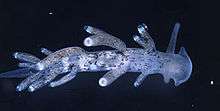Tenellia adspersa
Tenellia adspersa, common name the miniature aeolis, is a species of very small sea slug, an aeolid nudibranch, a marine gastropod mollusk in the family Fionidae. It is the type species of the genus Tenellia.
| Tenellia adspersa | |
|---|---|
 | |
| A live individual of Tenellia adspersa, head end towards the right | |
| Scientific classification | |
| Kingdom: | Animalia |
| Phylum: | Mollusca |
| Class: | Gastropoda |
| Subclass: | Heterobranchia |
| Order: | Nudibranchia |
| Infraorder: | Cladobranchia |
| Superfamily: | Fionoidea |
| Family: | Trinchesiidae |
| Genus: | Tenellia |
| Species: | T. adspersa |
| Binomial name | |
| Tenellia adspersa (Nordmann, 1845)[1] | |
| Synonyms | |
| |
In Britain this solitary species is referred to as the lagoon sea slug.[2]
Description
The color of this nudibranch is generally pale yellow to light brown, with black speckles.[3] The length is up to 8 mm.[3]
Distribution
The indigenous distribution of Tenellia adspersa is the Northeastern Atlantic Ocean, the Mediterranean Sea, Black Sea and Caspian Sea.[3]
This species is fully protected in the United Kingdom under the Wildlife and Countryside Act 1981 since 1992.[4]
The species is thought to be introduced in:
- Chesapeake Bay, Virginia;[3]
- Massachusetts[3]
- San Francisco Bay, Elkhorn Slough, and Long Beach, California;[3]
- Coos Bay, Oregon.[3]
Ecology
Habitat
This small sea slug is found amongst hydroids and sometimes crawling along the substrate in coastal intertidal and shallow sublittoral zones, and is also found in estuaries. It prefers small rocks to sea grass bottoms, and occurs on man-made substrates as well. It prefers sheltered, low wave action waters.[3]
Life cycle
Adults produce up to 100 eggs.[3] Larvae are pelagic.[3] They are sexually mature at 20 days old.[3] Life span is less than one year usually.[3]
Feeding habits
This sea slug is known to rapidly devour hydroid colonies.[3] Tenellia adspersa is a carnivore feeding primarily on hydroids such as Cordylophora caspia.[3]
References
This article incorporates public domain text (a public domain work of the United States Government) from the reference.[3]
- Nordmann, Alexander von, (1845). Versuch einer Natur- und Entwicklungsgeschichte des Tergipes Edwardsii. VI. Serie. Memoires, presentes parr Divers Savants. Memoires de l'Accademie Imperiale des Sciences de St. Petersbourg. 6 series, seconde partie 4(6):497-602.
- 2001-2007 Action plan for Tenella(sic!) adspersa Archived 16 June 2006 at the Wayback Machine. UK Biodiversity Action Plan, Joint Nature Conservation Committee
- Fofonoff PW, Ruiz GM, Steves B, & Carlton JT. 2003. "Tenellia adspersa". National Exotic Marine and Estuarine Species Information System. Access Date: 10-Mar-2017
- Protection for wild animals on Schedule 5 of the Wildlife and Countryside Act, 1981. website accessed 7 August 2009.